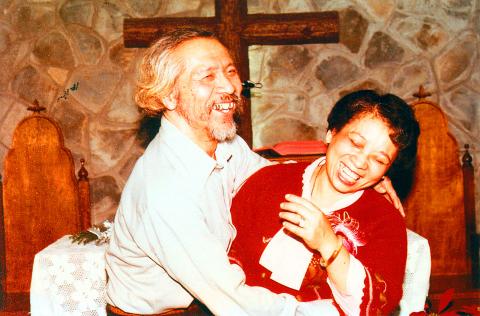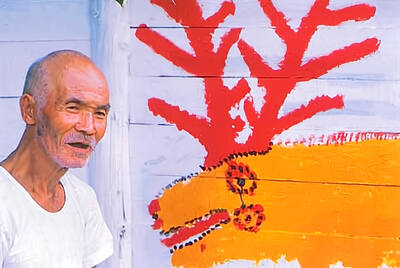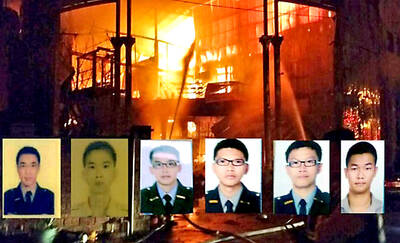To describe a documentary about Taiwan’s democracy movement as an epic love story may seem odd, but that’s what Hand in Hand (牽阮的手) feels like. The latest work by director couple Yen Lan-chuan (顏蘭權) and Juang Yi-tzeng (莊益增) threads together interviews, found footage, animation, archival records and manuscripts to tell of the six-decade relationship between democracy activists Tien Meng-shu (田孟淑) and Tien Chao-ming (田朝明). The couple’s undying love alone, however, is not enough to make the film epic. What transcends the romance is the director’s ambition to join the personal and the political, bringing the country’s past to life through the stories of individuals who lived trough it.
The film begins in 1950s Tainan. A 17-year-old high school girl, Tien Meng-shu, falls in love with Japanese-educated physician Tien Chao-ming, who is 16 years her senior. The young woman’s wealthy, reputable family does not approve of the town doctor, so she elopes with her lover and never returns home. Little did the fearless young lady know that their lives over the next 60 years would closely follow the thread of Taiwan’s post-World War II political history.
The progression focuses on Tien Meng-shu, who grows from an innocent schoolgirl to a devoted advocate of human rights and democracy better known as Mama Tien (田媽媽) among political activists and dissidents. The directors rely heavily on Mama Tien’s memory to conjure up the past, but instead of using archives and talking heads, they ingeniously use animation to bring the story to life. Through the animated sequences, we come to know doctor Tien’s friendship with Taiwanese intellectual and political critic Lee Wan-chu (李萬居) and Chinese scholar and democracy pioneer Lei Chen (雷震), who co-founded Free China (自由中國), a publication that advocated liberalism and was sharply critical of the Chinese Nationalist Party (KMT). The couple become intensely involved in the dangwai (黨外, outside the party) movement, and their clinic becomes a place where political dissidents such as a young Chen Chu (陳菊) — now mayor of Greater Kaohsiung — hold meetings with members of Amnesty International in an attempt to rescue political prisoners and victims of the White Terror.

Photo courtesy of Juang Yi-tzeng and Yen Lan-chuan
One of the film’s heartbreaking moments is an animated sequence depicting Yeh Chu-lan (葉菊蘭), the wife of human rights activist Deng Nan-jung (鄭南榕), as she decides not to stop her husband from setting himself aflame in protest against the lack of freedom of speech under the authoritarian rule of the KMT in 1989. Another sequence shows the Tiens’ oldest daughter, Democratic Progressive Party Legislator Tien Chiu-chin (田秋堇), going to Lin I-hsiung’s (林義雄) home on Feb. 28, 1980, and discovering the appalling murders of Lin’s 60-year-old mother and seven-year-old twin daughters while he was detained on charges of insurrection.
Completed after four years of arduous work by the makers of Let It Be (無米樂, 2005), Hand in Hand brings to light political events such as the 228 Incident, the Formosa Incident and the lifting of martial law not as hollow dates in history books but as parts of people’s lives, showing the passion, strength and sacrifice that helped to shape Taiwanese society.
The film owes much of its power to its protagonists, who are ready to die for their ideals and beliefs. Through this lens, the Tiens’ love for the land remains untainted and incorrupt, and so is the love between the couple as the aged Mama Tien is seen caressing the bedridden Tien Chao-ming, who lost his ability to move and communicate after a stroke in 2004 and passed away last year at the age of 93.

Photo courtesy of Juang Yi-tzeng and Yen Lan-chuan
In the middle of the film, director Juang acts as an off-screen narrator pondering a young blogger’s remark: “How does the 228 Incident have anything to do with me?” The question is answered in Hand in Hand, a must-see for anyone interested in the history of Taiwan’s democracy movement, and even more important for those who don’t think it affects them.

It’s always a pleasure to see something one has long advocated slowly become reality. The late August visit of a delegation to the Philippines led by Deputy Minister of Agriculture Huang Chao-ching (黃昭欽), Chair of Chinese International Economic Cooperation Association Joseph Lyu (呂桔誠) and US-Taiwan Business Council vice president, Lotta Danielsson, was yet another example of how the two nations are drawing closer together. The security threat from the People’s Republic of China (PRC), along with their complementary economies, is finally fostering growth in ties. Interestingly, officials from both sides often refer to a shared Austronesian heritage when arguing for

Nov.10 to Nov.16 As he moved a large stone that had fallen from a truck near his field, 65-year-old Lin Yuan (林淵) felt a sudden urge. He fetched his tools and began to carve. The recently retired farmer had been feeling restless after a lifetime of hard labor in Yuchi Township (魚池), Nantou County. His first piece, Stone Fairy Maiden (石仙姑), completed in 1977, was reportedly a representation of his late wife. This version of how Lin began his late-life art career is recorded in Nantou County historian Teng Hsiang-yang’s (鄧相揚) 2009 biography of him. His expressive work eventually caught the attention

Late last month the Executive Yuan approved a proposal from the Ministry of Labor to allow the hospitality industry to recruit mid-level migrant workers. The industry, surveys said, was short 6,600 laborers. In reality, it is already heavily using illegal foreign workers — foreign wives of foreign residents who cannot work, runaways and illegally moonlighting factory workers. The proposal thus merely legalizes what already exists. The government could generate a similar legal labor supply simply by legalizing moonlighting and permitting spouses of legal residents to work legally on their current visa. But after 30 years of advocating for that reform,

Cheng Shao-shu (鄭少書) was advancing alone through a smoke-filled corridor in Miaoli, when he suddenly realized he couldn’t breathe. The firefighter tore off his mask, only for the hot air to scorch his lungs. Gasping, he snapped the mask back on and scrambled out of the inferno. Cheng says he survived the fire only because he was near a door; had he been deeper inside the building, he wouldn’t have made it out. “It may not be the toughest job, but it is certainly one of the most dangerous,” Cheng says. Over the past two decades, 77 firefighters have died in the